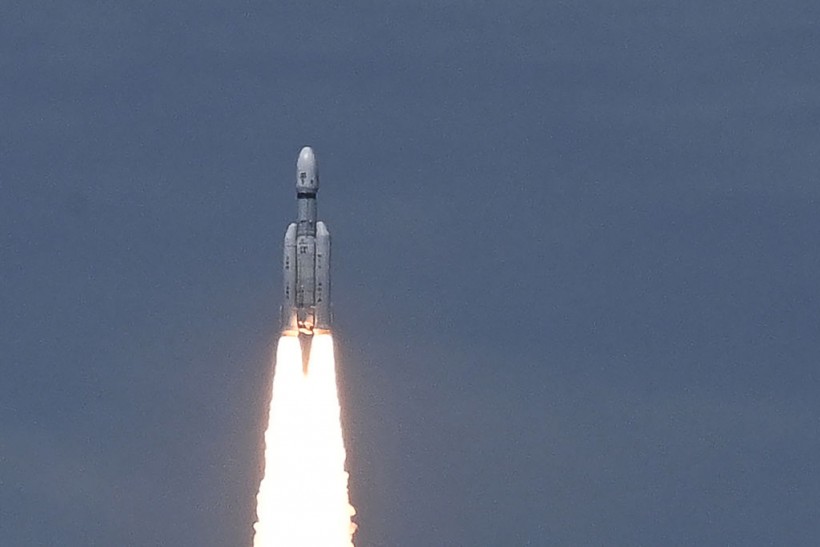India has unveiled initial Moon images before its highly anticipated lunar landing attempt later this month. The populous nation aims to be the fourth to achieve a controlled Moon landing, potentially being the first to do so near the south pole, MailOnline reported.
Chandrayaan-3, in lunar orbit since August 5, captured enlarging craters as it approached its target. If successful, the lander and rover will land near the Moon's unexplored south pole on August 23, marking a significant milestone.

An Indian Space Research Organisation (ISRO) rocket carrying the Chandrayaan-3 spacecraft lifts off from the Satish Dhawan Space Centre in Sriharikota, an island off the coast of southern Andhra Pradesh state on July 14, 2023.
Chandrayaan-3's First Image of the Moon
Indian Space Research Agency (ISRO) has revealed the first images captured by the Chandrayaan-3 spacecraft after it entered lunar orbit on Saturday.
According to BBC News, the images exhibit the progressive enlargement of lunar craters as the spacecraft approaches its destination. Scheduled for a surface arrival on August 23, Chandrayaan-3's lander and rover hold the potential to establish a controlled "soft landing" near the moon's south pole.
Should the mission succeed, India will achieve a historic feat, becoming the first nation to accomplish a controlled lunar landing in this particular region. Such a triumph would place India in a select group, alongside the United States, the former Soviet Union, and China, which have achieved soft landings on the moon.
After approximately ten days of orbiting the Earth, Chandrayaan-3 was transitioned into translunar orbit last Tuesday, culminating in its successful insertion into lunar orbit on Saturday. ISRO asserts that the spacecraft is in optimal "health" after passing all assessments. Notably, this achievement marks the third consecutive instance where ISRO effectively positioned a spacecraft in lunar orbit.
Chandrayaan-3, a continuation of India's lunar exploration initiative, aims to build on the accomplishments of prior moon missions. This endeavor follows India's initial moon mission in 2008, which disclosed the presence of water molecules on the moon's arid surface and identified the existence of a daytime lunar atmosphere.
Chandrayaan-2, launched in July 2019, consisted of an orbiter, a lander, and a rover. Although the orbiter continues its lunar studies, the lander and rover were unsuccessful in their soft landing attempt and crashed upon touchdown.
READ ALSO: Indian Space Research Organization (ISRO) Set To Launch Lunar Lander Chandrayaan-3 Next Week
India's Lunar Missions
After years of dedicated effort by Indian engineers, the country debuted its first lunar endeavor, Chandrayaan-1, to search for water molecules on the moon's surface. Subsequently, Chandrayaan-2, eleven years later, effectively entered lunar orbit, yet its rover encountered a crash landing on the moon's surface during its mission to explore the South Pole region.
As per CNN, India's space program has a history spanning over sixty years, originating when the country was a newly independent nation recovering from a partition and economic challenges.
Its initial foray into space, a rocket launch in 1963, paled in comparison to the ambitious space endeavors of the US and the former Soviet Union, which led the space race.
In the present day, as the world's most populous nation and the fifth-largest economy, India's space aspirations have been rapidly advancing under Prime Minister Modi's leadership. The recent launch of Chandrayaan-3, celebrated by Modi as a significant accomplishment, signifies a new phase in India's space journey. The country has invested around $75 million into this mission.
RELATED ARTICLE: India's Chandrayaan-3 Mission Successfully Starts Journey to the Moon's South Pole
Check out more news and information on Space in Science Times.




![Earth's Quasi-Moon Kamo‘oalewa Could Originate From Lunar Surface Not Asteroid Belt [Study]](https://1721181113.rsc.cdn77.org/data/thumbs/full/53275/89/56/50/40/earths-quasi-moon-kamo-oalewa-could-originate-from-lunar-surface-not-asteroid-belt-study.png)









